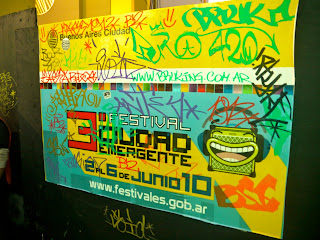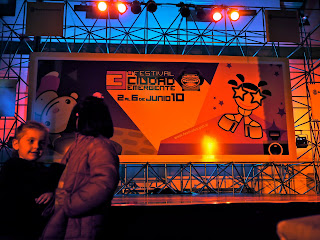Sunday, June 20, 2010
Tuesday, June 15, 2010
Monday, June 14, 2010
Hip-Hop on the Rise: Cuidad Emergente



Wednesday, June 2, 2010
Saturday, May 15, 2010
Saturday, May 8, 2010
Negro Tango: Exposing the black roots of the white facade
1.) A tango picture.
You’ll always see the pale faced, dark haired couple dancing gracefully across the cover of most books on Argentina. Tango is the undoubted symbolic gesture that Buenos Aires gladly accepts to top the front of it’s national mythology.
yup. just go ahead and google Buenos Aires Tango. It all looks like this...
2.) The second thing that they’ll always tell you is that all of the black people are dead and gone. Of course, the language is more flowerly, but there will be a basic explanation that, dammit, this ain’t Brazil, if you were lookin for brown or black, you’ll have to go back to Africa.
Although there is some truth to both of these images, and statements, they are both indicative of the national mythology of Argentine whiteness that is exported in mass proportion.
As I wrote in my thesis:
"The reality is that tango started as a slave dance. It was danced in brothels, in the depths and dark crevices of the society that the Europhile elite of Buenos Aires didn’t want to accept. The dance had a wily percolacion upward through Cuba, and even ended up on tour in France, and other parts of Europe. It was only this contact with European hands that the dirty dance of slaves, and the lower class Italians who cohabitated with them, became the image of Argentine tango that we now see. This tango that glistens among chandeliers and fancy tacones that do flippant twists over waxed parquet--this tango is a complicit conversation between the throngs of tangoing tourists, and the few Portenos that actually DO the tango."
There were two events this month that focused on the African roots of Tango as musicologist Nestor Ordigo released his book about just this topic. The first took place at the annual Feria de Libros…which is toted to be one of the most important gatherings of literature, authors, academics, blabbity blabbity blah…
Maybe I’m missed all of the rich cultural exchange but I just saw it as an excuse to charge people entrance to pay exorbitant prices for books they can find more easily on mercardolibre (Argentine ebay).
Or perhaps it was just my general discomfort and discontentment with the presentation that I went to about Afro-Argentines.
Now, admittedly I walked in a bit late, but I was advised that I hadn’t missed anything. I grabbed a seat next to a few recognizable faces in the community. When I arrived, Pablo Cirio, a well known Afro-Argentine musicologist here was in a slide show that appeared to be describing each setting, and story of each black face.
“Que me falto…de que esta hablando?”
“Negros”
he whispered to me simply.
“Mostrando fotos de gente negra?”
“Si,”
And there it was, Afro-Argentine academia often decomposes into the primary process of just explaining to others that black people EXIST. Here is one, here is another, I’m friends with this one, oh and that one too.
The perfect way to end a presentation about the Afro-Argentine roots of tango that had nothing to do with the Afro-Argentine roots of tango with a tango done by an afro-BRASILIERA, and afro-URUGUAYO. Maybe it makes sense in some post-modern way somewhere?
To be a bit less critical, the European mythology of Argentine is a pretty brick wall to try to navigate. It shows a lot about the current pervasive ideology of invisibilization that exists in Buenos Aires, especially. Though in America we don’t see very many American Indians, and our national history is just a euphemized story of their massacre, you will hear very few people deny that there was ever a population of Indians. Most people won’t tell you that they just don’t exist anymore. That we just “don’t really have that problem”...
Perhaps a slide-show of black faces is the first political step that the Afro community has to make…but I’m inclined to say….so what??
Anyways, the second event I was initially very excited about:
In a tango museum, a small charla about the Afro roots in tango, then Rosa Montero, a middle-class black Portena was going to sing some of the “negro tangos”.
The museum was very interesting, especially in it’s inclusion of afro-argentine history, but the event left a bit to be desired. First of all, I had dragged along a friend and my roommate Emilse ( a tango lover) with the promise of an Afro-Argentine tango. We arrived to a small and packed room with two speakers set up and a pasty faced red head reeking of adolescent rebellion at the helm of the laptop.
Next, who grabbed the mic but our silly musicology professor with the black-faced-slide-show.
His introductions showed that he could switch around the words negro-and tango quite apty.
“So llegamos a este evento para hablar sobre los tangos negros. Si estamos aca para todo que ver con los negros en tango. Si, los Afro-tangeros if you will”
I must admit I was a bit volanda at the time, but I was confused when an older white gentlemen with an admitted “cara de orto”. Who is this apartato??
As it seems, he must have some type of pact with the academics who planned the event, or a pact with the devil to be able to keep a straight face through the largest JOKE of a song that I’ve ever heard.
With his ill timed, flat, silly-faced, no feelinged, stiff arm (I can go on and on) delivery, I literally had to put my camera on my lap so as not to waste my arm strength. May I say it again,Who is this tool??
At one point, about half way through the eternity of this horrid spectacle, mid-breath, before this chavon was about to let out another limp and languid sound
**FELICITACIONES!!! VOS PODÉS GANAR UN IPOD TOUCH**
The man angrily and bitterly looked at the adolescent who was surfing the web to pass the time (oh I wish I had a web to surf too…) and they decided that they would move onto the next song as that one had “a glitch”. In my trying my very hardest to suppress laughter…I noticed my roommate out wandering the hallways of the museum. I couldn’t blame her.
After a few more songs, and a pitifully staged shout for an encore (why is that TWO people clapped and shouted for the SAME song) I smell a set up here, and I was ready to protest….
Rosa Montenero…this middle classed Afro-Argentine who in all of her 70 something years was fabbed out in a very middle classy way. No cleavage, but happy patterns. Jewelry glittery enough without being hookerish? I dunno.
She explained that as all singers were, that pronounce and pronounce that they are singer and despues cuando nos toque ya estamos resfriadas…
She was sick, and losing her voice, but she would make the concert happen.
After four songs, she called in quits in her tango esque style
“No puedo mas” she whispered, gently cradling her throat….
I asked my roommate, the tango lovah for her recap of the event. I asked her to tell me in English so that we could talk about the event freely. (If the poor chavon happened to understand English, well, perhaps it was only right that he was brought down by a yanqui imperialist)
“That…” Emi started empathetically (and remember you have to picture all of this happening in her accent from a very specific part of Liverpool) “was the most terrible….awful…”
she started fishing for adjectives so I started to turn it into an English synonym lesson
“piss poor…embarrassing…pice of crap...ugly...undesirable...offensive” I offered
“excuse for a tango that I have ever seen. I had to leave to stop myself from laughing at this man”
For some laughs….check out some outtakes from the show. Well, actually, they are really just clips from the event, but they should be outtakes because of my shaky cam, and his shaky voice.
At least the museum had an impressive display of Afro-Argentine representation in thier story of the tango:
Various books on display on the Afro roots of the tango.




